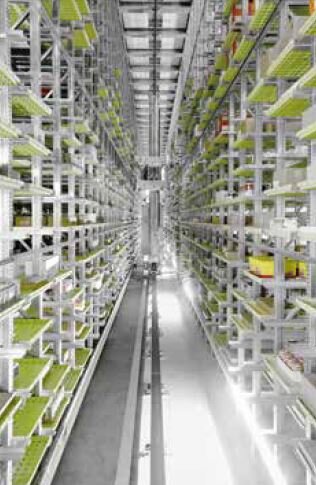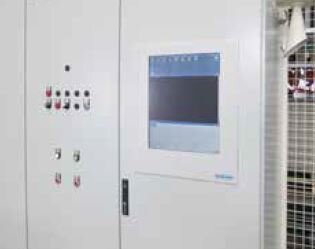Migros pioneering logistics processes
- Industries
- Agroalimentaire
- Client
- Migros
Fully automatic order picking with Witron and Yaskawa
With more than 40 companies and 600 supermarkets, Migros is one of Switzerland’s biggest corporate groups. To ensure that all goods are dispatched to the correct destination in this network, a record-breaking high-bay warehouse was put into operation at the distribution centre in Suhr.
Gargantuan logistical requirements
It is no easy task to supply dried goods to more than 600 locations in Switzerland from a single logistics centre within 24 to 48 hours. Stockpiling at home is a thing of the past. Most consumers buy whatever they need spontaneously. Shelf gaps are no longer tolerated today. In addition, consumer demand is subject to fluctuations due to weather conditions, advertising and social trends. Retailers cannot allow high stock levels to build up, but they must ensure continuous, individual, fast and needs-based delivery to their branches. In line with these requirements, the Migros distribution centre in Suhr, Switzerland, has realigned its logistics processes in respect of service, ergonomics, flexibility and sustainability.
Pioneering OPM logistics system
The main distribution centre has been in existence since 2000, but initially the goods were mainly order picked by hand. Today the warehouse has a fully automatic OPM system (order picking machinery) which was planned and executed by logistics experts Witron Logistik + Informatik GmbH. As a general contractor
the latter was responsible for the entire planning and implementation of all material flow, IT, controller and mechanical components.
So as not to affect the delivery processes, the changes had to be performed parallel to operations. Centrepiece of the fully automatic warehouse and order picking system OPM is the case order machine (COM), which stacks a wide variety of different trading units on the basis of a stacking algorithm store-specifically and tightly packed on order pallets.
OPM is also fully flexible with regard to the filling level of the pallets. If, for example, only pallets of a certain height grid can be delivered to a market due to structural limitations, the system will take account of this parameter. The articles are already sorted on the pallet at the order picking stage, so that they can be filled into the shop shelves by the shortest way possible.
Fully automatic flow from incoming to outgoing goods
Instead of gripping, the COMs push the articles exactly to the position on the order pallets that has been calculated by the system. “Conventional gripping technology would have seriously limited the bandwidth of automatically order picked goods and made the overall system more expensive,” explains Josef Pollinger, manager of the Migros project bei Witron.
The entire procedure is monitored by sensors to enable high availability. At a prior stage the products are fully automatically verified and received in incoming goods, stored on separate pallets in a high-bay pallet storage system, removed again as needed, depalletized in layers, married to trays of differing sizes, in upstream fine-tuning processes mechanically sorted and separated from the tray again prior to branchspecific order picking. Once the pallets have been picked, the OPM system transfers them to the wrapping stations, where they are secured with plastic film. Then the pallets are transported by a conveyor system to a buffer zone in the direction of outgoing goods, consolidated with other customer orders according to delivery tour and prepared for despatch.
Because Migros picks a large number of order pallets with beverages and PET bottles, efficient handling in the beverage sector was an important decision criterion for deploying OPM. The automatic insertion of an additional layer of cardboard as padding thus results in an increase in stability in beverage pallets.
Award-winning Witron logistics solution with SPEED7
Compared to conventional order picking procedure, the Witron OPM solution distinguishes itself by enormously high cost-effectiveness, quality and quantity. Yaskawa Vipa controllers have been deployed in the Migros COM system to ensure that all processes are executed quickly and reliably. According to the manufacturer, the CPU 317SN is one of the fastest automation components currently available on the market due to the integral SPEED7-ASIC.
Forty of these CPUs were installed at the Migros distribution centre. Compared to CPUs of the same performance class, their memory areas are of larger design and can be flexibly adjusted. A further plus point: Vipa controllers are programmed and commissioned in Siemens’ STEP7 – special training is not required.
The backplane bus of the SPEED7 CPU is highly efficient and reduces dead times in the control loops which are handled by the controller and fieldbus. The high processing speed also permits the operation of a larger number of controlled axes in one controller, as well as higher machine cycle times.
The compact design of the PLC and bus components has a positive effect on switch cabinet space. Due to the modular concept of Yaskawa Vipa the entire hardware can be individually geared to the project specifications. The customer only buys functions he really needs, but can supplement and extend these at any time. Besides the standard-backplane bus, the Vipa CPU has an optional SPEED bus for expansion with high-speed signal modules and communication processors. The two modules deployed here were specially developed for the purpose by Witron. Each is equipped with two masters, to which 512 slaves can be coupled, enabling a total of 112 double Interbus masters to be implemented. In addition, 16 serial communication processors were installed at Migros. Besides Interbus, PROFIBUS and Ethernet are also used in the Migros systems.
Best experiences in day-to-day operation
“With the introduction of OPM we have achieved all defined goals,” says Migros Division Manager Daniel Nussbaumer. The supply chain is considerably more stable and the processes are more transparent. Witron also used the fast Vipa controllers in other projects. “In highly dynamic systems – particularly at the start of normal operation – we strive for maximum reliability,” explains Stephan Schmid, team leader in Control Technology Development. The battery of the PLC plays an important role here, as it supplies power to the PLC memory in the event of a power cut. Backup batteries which must be monitored and replaced are no longer required. “Besides these reliable and efficient components, we also need a partner who is flexible enough for adjustments and always available to answer questions,” Schmid explains why Witron will be calling on the services of the innovative enterprise Yaskawa in future. “More than 10 years of active partnership with a global player like Witron make us very proud as a company. We should never be satisfied with what we have achieved, but continue to move forward,” adds Udo Richter, International Key Account Director at Yaskawa.





















